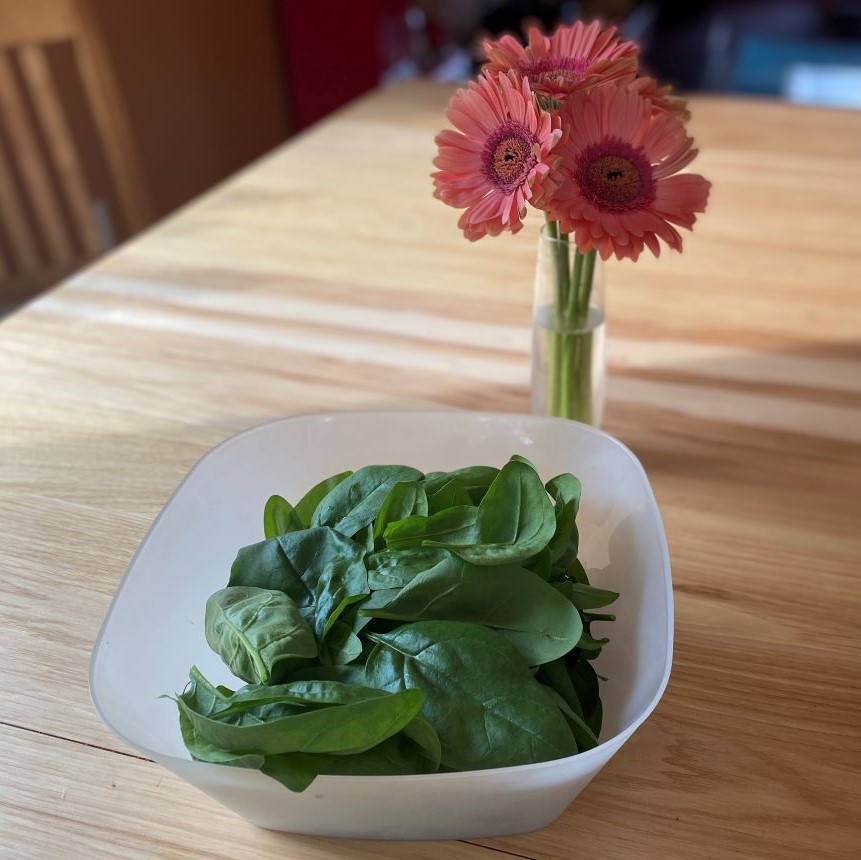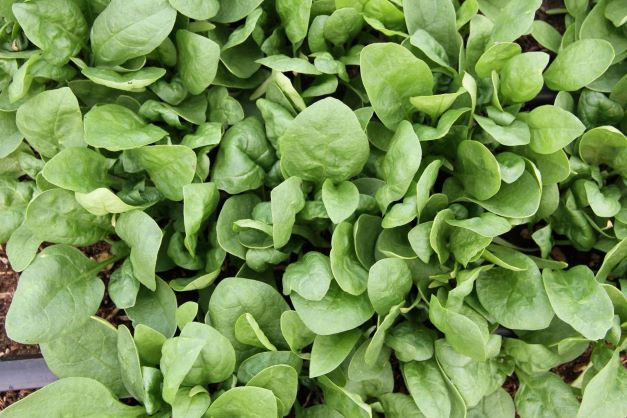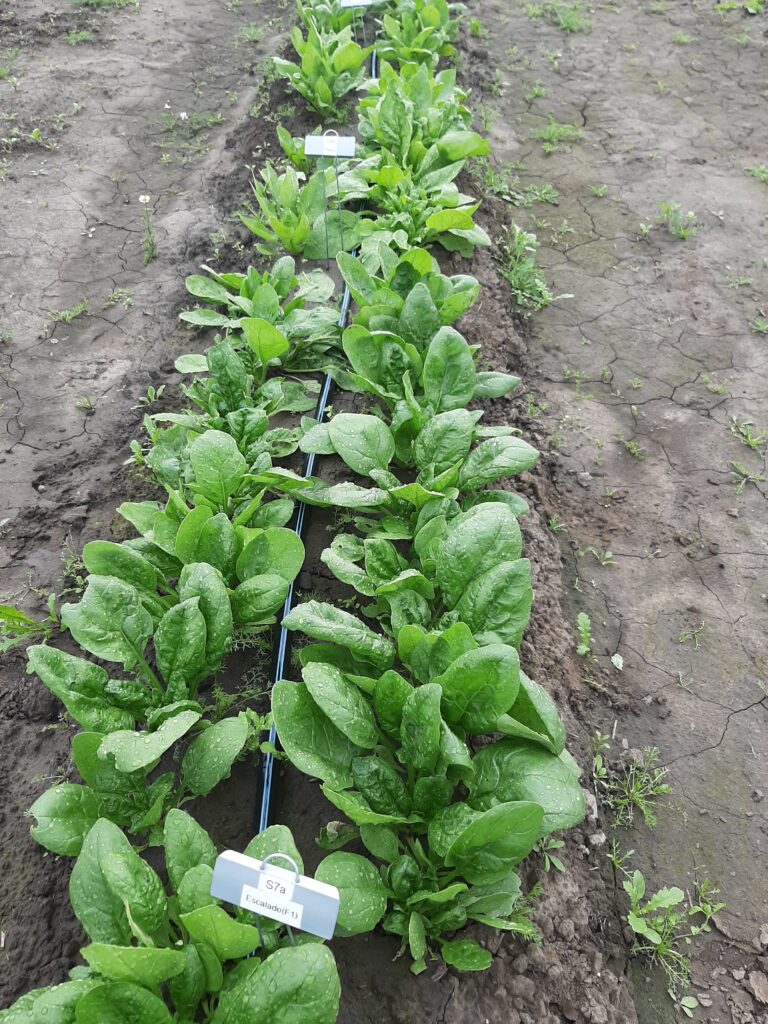I love fresh spinach so that’s why, even though much of the spinach I plant bolts (in other words, goes to seed), I always try again next year. One of the true pleasures of spinach is how quickly it grows. It is one of the first things I plant in the spring, as soon as the ground is workable, and the first thing I eat.
In my experience, bolting is THE challenge with growing spinach in Interior Alaska. Warm temperatures and long day lengths are mostly to blame, but big temperature swings and cold temperatures can also play a role in bolting as well. This article does a good job of explaining how cold temperatures trigger bolting (flowering) in spinach and other crops.

Spinach is usually direct seeded. It’s possible that transplanting spinach could help mitigate bolting, but trials are needed to assess this. Direct-seeded spinach should be thinned to four to six inches, or whatever spacing is specified on the seed packet. In my garden, I often do not get around to thinning my spinach, which might increase bolting rates, although Glenna Gannon, the director of the vegetable variety trials at the Fairbanks Experiment Farm, says that proper spacing did not reduce bolting rates in trials. Consistent watering also can help prevent bolting in spinach. Spinach leaves can be snipped with scissors and allowed to regrow for successive harvests until it bolts, making it inedible.
Johnny’s Selected Seeds has a nice comparison list of spinach varieties, comparing how fast they grow and how fast they bolt. Of those compared, Fairbanks growers will of course want to choose the slow bolting varieties. The ones listed as slow bolting are Corvair, Lizard, Seaside and Red Tabby. Not included in this comparison chart is Escalade. When Ada Snyder, a commercial grower sales representative for High Mowing Seeds, trialed spinach, she found that Escalade held (did not bolt) about two weeks longer than other varieties. She thought Kiowa, Lakeside, Seaside, Space and Lizard will be the most conducive to growing conditions in Interior Alaska.

Unfortunately, the faster maturing varieties are more susceptible to bolting, but all spinach varieties are susceptible to bolting in our long days.
In 1967, J.E. Parlevliet found that the rate of flower formation/rate of bolting in response to photoperiod disappeared at photoperiods of 20 hours and began to level off for some varieties closer to 16 hours. The rate of bolting still differed between varieties, but not in relation to the photoperiod. Fairbanks has a photoperiod/day length of 16 hours April 22 to Aug. 19 and a photoperiod of 20 hours May 27 to July 15. In other words, for most of the Fairbanks summer, the critical day length is so long that whether or not you plant the spinach early or late, it doesn’t really matter.

If you have a high tunnel or row covers and can plant before mid-April or after mid-August, this could make a difference in the likelihood of your spinach bolting. Warmer temperatures in mid-summer could make the spinach more susceptible to bolting, but temperature swings can also make it more susceptible to bolt. Although spinach is tough in that it is cold hardy, it’s also a bit of a goldilocks vegetable where it likes the weather not too hot and not too cold and the day lengths not too long.
Gannon explained that while more data from additional growing seasons will better inform recommended varieties for the Interior, trials in 2020 and 2021 suggest that Escalade, Space, Renegade and possibly Palco and Lizard hold best across both summer and fall plantings. Seaside and Oceanside are delicious varieties, but do not appear to hold as well in the field. Red Tabby and Kiowa, both considered varieties that are slow to bolt, have not been trialed yet.

Corvair, Space, Melody, and Tyee are recommended by Extension for Interior Alaska, but according to Gannon, Melody and Tyee seeds are difficult to find and likely the varieties have been improved. Terry Reichardt, Fairbanks gardener extraordinaire, prefers Kookaburra spinach. It is a semi-savoyed spinach which means it’s also a little less tender than spinach proper and might be best cooked than raw. New Zealand spinach, which is not actually in the spinach family, is prolific and doesn’t tend to bolt. When cooked, it is a good spinach substitute, but when eaten fresh, it is tougher than many spinach varieties.
Best bet? At this point, I would suggest Escalade or Space for fresh spinach as top picks. Palco, Red Tabby, Kiowa, Corvair, Lakeside, Seaside, and Lizard may also be good ones to try. Hopefully future trials will identify varieties and production methods best suited to the Midnight Sun. If you plan to cook your spinach, try semi-savoyed Kookaburra or skip spinach all together and try New Zealand spinach, kale, or Swiss chard. Make sure your spinach is well watered, spaced appropriately, and try growing it under a row cover or low tunnel.
This article offers a more in depth look at producing spinach, albeit in Midwest growing conditions. Also, check out the complementary video below.
Previously published in the Fairbanks Daily Newsminer April 17, 2022.